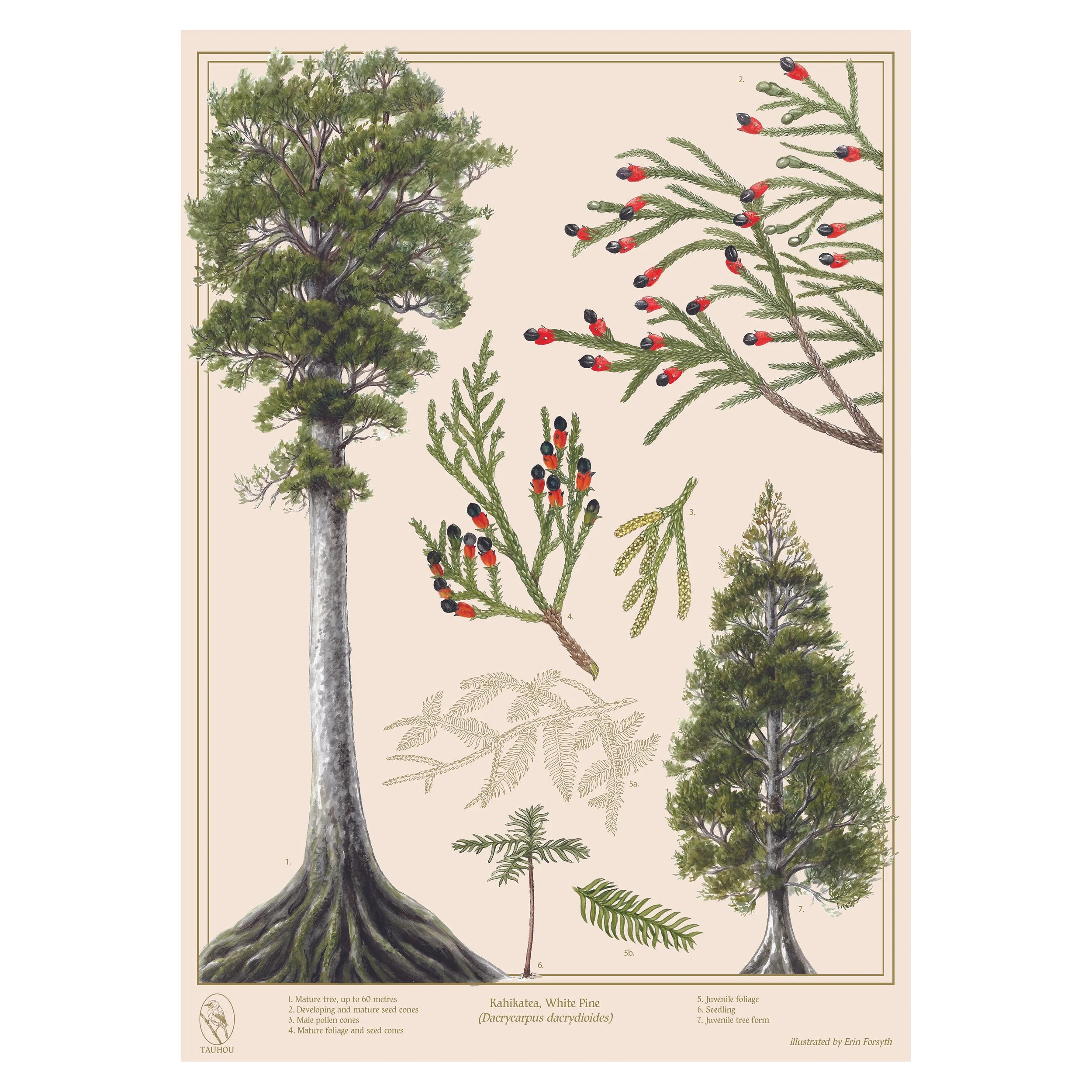Rimu & Kahikatea
Rimu & Kahikatea
Rimu (Darcydium cupressinum) & Kahikatea (Dacrycarpus dacrydioides)
I made these botanical illustrations to share the beauty I see in these special native trees and some of the things I have gotten to know about them. These trees ‘fruit’ at different times to many other natives supplying an important food source for manu Māori, native birds when other trees and plants are out of season.
These illustrations are available as artist quality open edition prints on 210gsm acid free paper. Buy them individually as A3 or as a set for your home. A percentage of sales from each of these prints sold goes towards the Kākāpō Recovery Group for this season. Funds from all sales through my website support my practice researching and illustrating the irreplaceable native flora and fauna and sharing the outcome of my experiences.
Rimu & Kahikatea are ‘rākau rangatira’ or ‘chiefly’ trees and are significant in many ways. Learn more below!
A good way to identity the juvenile trees is looking at their foliage with a creative eye. The rimu is said to share a linguistic tie to ‘limu’, meaning moss in some Pacific languages. The Latin ‘cupressinum’ reflects the early botanists association of the ‘weeping’ branches like the Cypress tree (Cupressus pendula).
Kahikatea foliage is more upright and ‘feather’ like. It is thought to have grown from a feather dropped…but I’ll leave you to discover that story…
In Autumn every year a small team of dedicated volunteers and staff from the Department of conservation gather together to measure the productivity of the rimu for the season. It is thought that kākāpō will only breed in a year when the rimu fruit is abundant. There are only 243 of these birds left so every breeding season is closely monitored in the hope of seeing an upward trend in breeding.
When they reach their full maturity they reach heights of up to 60 metres emerging from the forest canopy. Like other conifers (Gymnosperms) as juvenile trees they have a somewhat conical form but drop their lower branches on the way up revealing straight girthy trunk which attracted the commercial interest and the saw of the early European settlers when kauri became scarce.
Kahikatea likes damp and even swampy conditions which meant is survived a lot of the burn off of native bush from pastural land and you will see small stands of them on farmland throughout te-ika-a-Maui. Their wood is actually quite soft and was quickly discovered to be unsuitable for building. But as kauri diminished, dairy increased and kahikatea were targeted to produce containers for the boom in dairy exports.
Rimu & kahikatea are endemic conifers - only found in Aotearoa. This ancient lineage of plants which evolved 380 million years ago! Flowering plants (Angiosperms) did not appear until millions of years later. The conifers use cones to reproduce. A male cone has pollen and the ‘fruiting’, female cone bears the seed.
Rimu and kahikatea belong to a smaller group within the Gymnosperms called the Podocarps. The ‘fruit’ of plants in this genus occur at the end of branchlets and are actually swollen leaf brackets. Unlike more familar plants like an apple the podocarp seeds actually sit on the top of the fruit, or more accurately, on top of the cone when the cone/fruit is fully ripe. Developing seed cones & male cones also feature in these designs.



